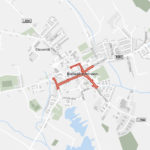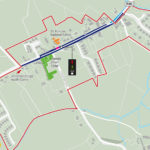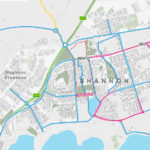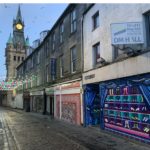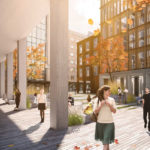Transforming Ireland's town centres into destinations to stay, enjoy, and socialise.
The Pedestrian Pound Study (2018)[1] by Living Streets suggests that well-planned improvements to public spaces can boost footfall and trading by up to 40%. Irish towns and villages provide inspiring examples of pedestrian-focused public realm improvements, successfully bringing vibrancy back into the towns.
Irish towns and villages often share common transport features which contribute to the low attractiveness of their respective centres; this in turn has led to persistent commercial vacancies.
Typical transport features commonly seen include:
- Town centres dominated by roads
- Town centres dominated by car parking
- A lack of pedestrian crossing points and a general lack of connectivity
- A lack of focal points for pedestrian routes through the town (required to give balance to wide streets and through traffic)
- A lack of cycle parking provision (short stay and long stay)
- A lack of social activities taking place on-street
- An increased reliance on the car
- Limited attractiveness of the town centre (often a place to pass through rather than a destination in itself)
What did we do?
We researched several public realm strategies showcased in the Royal Institute of the Architects of Ireland (RIAI) Town & Village Toolkit[2] that sought to reverse the observed trends by applying the techniques recommended in the toolkit to our own schemes.
What was the objective of the RIAI Town & Village Toolkit?
The objective was to transform town centres into destinations to stay, enjoy, and socialise (rather than being places to simply pass through without interaction). This is an approach that we also bring into our work at Momentum when designing transport strategies.
What worked well?
1. Re-allocating road space and on-street car parking to improve pedestrian routes, create squares and introduce cycle lanes and cycle parking. Westport, Co. Mayo
Westport public square was formerly surrounded by car parking, which contributed to the low attractiveness of the town centre. However, a coherent design strategy, the Town Design Statement ‘Westport 2000’ was adopted and this led to the removal of car parking near the Town Hall. The space this created provided the opportunity to introduce a new square (complete with public art), which effectively enhanced the town centre’s sense of place and encouraged the local community to visit, stay and enjoy the improved space created.
Before
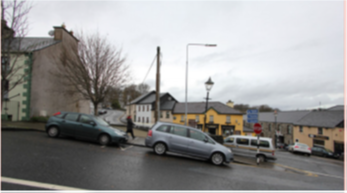
After
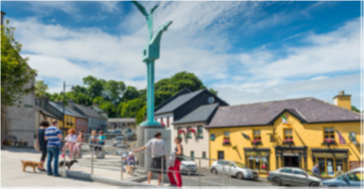
Momentum Case Study
In Ballaghaderreen, Momentum supported architects BDP by providing transport advice for a similar public realm enhancement project. Our work included an assessment of the evidence available that could support a reduction in the number of car parking spaces provided in the Market Square (which is currently dominated by cars). Opportunities to provide better walking and cycling connections between the core centre and the rest of the town were also explored as part of this assessment work. It was discovered that these connections could be provided by redesigning a key junction, relocating existing bus stops, and implementing one-way streets where appropriate. Integrating these transport considerations into the public realm strategy will contribute to the transformation of the Market Square into an attractive destination for pedestrians and cyclists.
2. Introducing traffic calming measures to make the environment more pedestrian friendly. Thomas David Square, Mallow, Cork
In Mallow, Thomas David Square was transformed from a car dominated area into a pedestrian friendly plaza. Vehicular traffic was reduced from two lanes to one and this provided more space for pedestrians; improved pedestrian links and more crossing points at critical locations could then be delivered. These provisions improved the pedestrian experience through the area, making journeys by foot more pleasant and safer, whilst also creating a space that people wanted to reside in and enjoy.
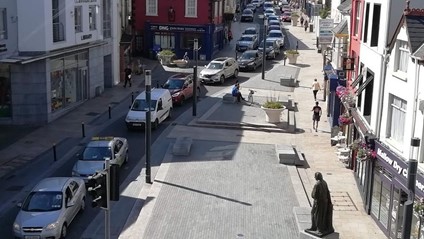
Momentum Case Study
Momentum is supporting LDA Design with similar work for Phoenix Road in London. The Phoenix Road corridor provides an important connection for walking trips between Kings Cross and Euston stations in the London Borough of Camden, however it is under-used by pedestrians and is dominated by car parking. Traffic and pedestrian surveys as well as car parking data were interrogated to inform option development, which has included several strategies to introduce road closures and one-way systems in the wider area. The objective is to re-allocate the generous road space for pedestrians and cyclists, improve connectivity and create a place for the local community to stop, rest and interact. We supported LDA with a ‘play day’ for the local community to get their feedback about concept design options that have been developed.
3. Undertaking analysis of the local context: events, traffic flows, and pedestrian movement to increase the local community’s support, Tobar Place, Tubbercurry, Co. Sligo
In Tubbercurry, a holistic analysis of the local context, calendar of events, pedestrian routes and traffic flows was essential to devise an informed public realm strategy that worked for the local community. The holistic approach undertaken was required in order to effectively consider the wide variety of stakeholders that would be affected by the proposals.
As part of the proposals, Tobar Place, which used to be surrounded by parked cars, became a terraced platform and provided a new pedestrian though route; this new route linked with other existing pedestrian routes that connect with the town centre, thus improving pedestrian connectivity throughout the locale.
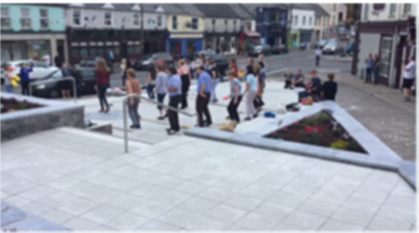
Momentum Case Study
In Co. Kildare, Momentum supported Brady Shipman Martin to undertake a series of health checks/urban design analysis for six rural settlements. These settlements currently experience a lack of pedestrian and cycle priority, partially due to the lack of onward connectivity and appropriate infrastructure. The health checks subsequently provided a baseline analysis to inform the development of urban renewal plans for each town and village. We conducted a thorough analysis of traffic, cycle, and pedestrian movements across the six settlements to ensure that our recommendations aligned with local requirements anddesires. Our input included the provision of information on the local context; this information will inform the identification of key areas that require improvements for pedestrians and cyclists.
4. Creating meaningful journeys through the public realm, Waterford
In Waterford, the distinct lack of good-quality pedestrian links was detrimental to the attractiveness of the cultural heritage of the area. New, good-quality public spaces and pedestrian links were created by removing car parking spaces; this provided the opportunity to facilitate journeys by foot via interconnected and historic streets.
The strategy contributed to a unique blend of place-making that was aligned with history; the strategy followed the principles of ‘1000 Years in 1000 steps’, and new museums were aligned in chronological order. The three museums now attract 105,000 visitors per year and seventeen retail premises have opened since 2011.
Investments dedicated towards improving pedestrian environments has resulted in increased footfall. In addition to the social value of providing great spaces for people to enjoy, the more regular use of public spaces has also subsequently generated significant economic gains for town centre businesses.
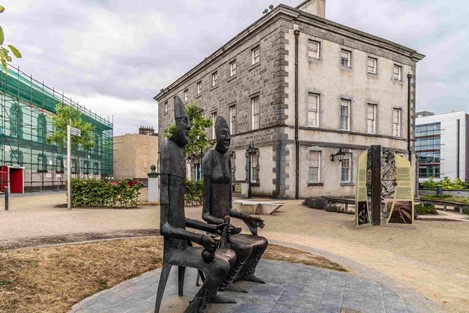
Momentum Case Study
Momentum’s current work supporting BDP on the Shannon Town Masterplan includes similar considerations for pedestrian journeys through the wider area. Our work involves planning for improved walking and cycling links, particularly connections with the industrial ‘Free Zone’ to the east of the town, as well as creating enhanced public realm on the proposed high street providing access to the local retail facilities.
We always place people at the centre of our work. We’re proud that our work across the world – including these examples in Ireland – shows how progressive transport and pedestrian strategies contribute to the creation of vibrant places that deliver benefits for all.
